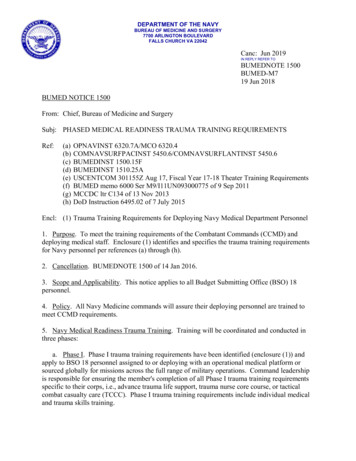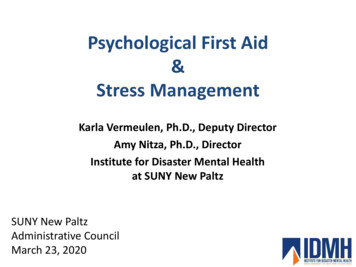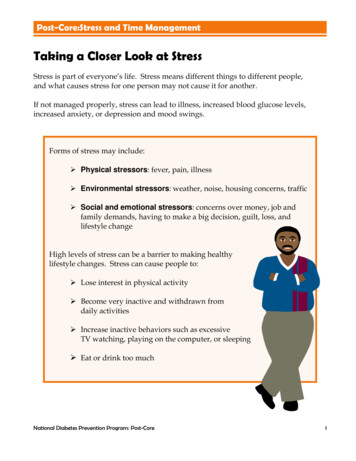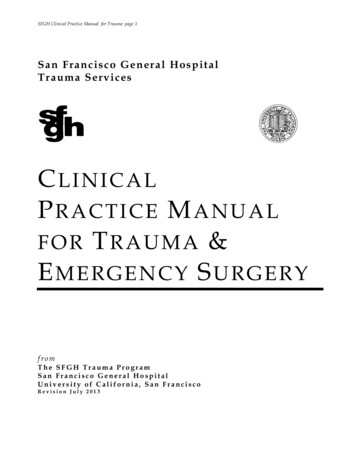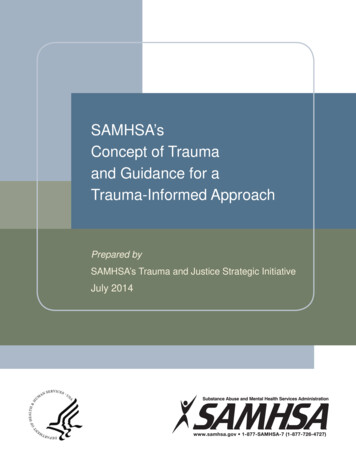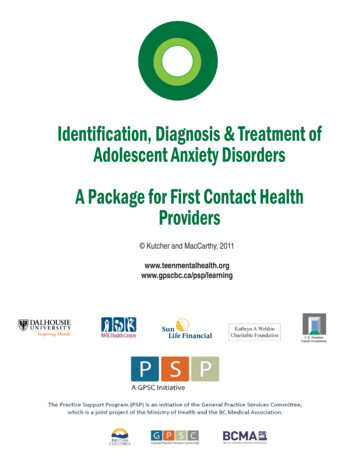
Transcription
Trauma and Stress-RelatedDisorders in DSM-5Matthew J. Friedman MD, PhDNational Center for PTSDGeisel School of Medicine atDartmouth
DisclosuresSources of Research SupportPaid Editorial Relationship1. U.S. Department of VeteransAffairs2. U.S. Department of DefenseNoneConsulting RelationshipPRNStock Equity ( 10,000)NoneSpeaker’s BureauNone
Bottom Line1. Because a variety of clinical phenotypes areconsistent with PTSD diagnostic criteria, it can nolonger simply be considered an Anxiety Disorder2. This is reflected in the new DSM-5 chapter:Trauma and Stressor-Related Disorders3
DSM-5: Metastructure Neurodevelopmental DisordersSchizophrenia Spectrum & Other Psychotic DisordersBipolar & Related DisordersDepressive disordersAnxiety DisordersObsessive-Compulsive, Stereotypic & Related DisordersTrauma- and Stressor-Related DisordersDissociative DisordersSomatic Symptom Disorders etc.American Psychiatric Association. (2013) Diagnostic and Statistical Manual of Mental Disorders, (5th ed.). Washington, DC: Author.
DSM-IV Anxiety Disorders in DSM-5 Anxiety DisordersPanic, Specific Phobia, Social Phobia, GAD etc. O-C, Stereotypic & Related DisordersOCD, Body Dysmorphic, Hoarding, Hair Pulling, SkinPicking, etc. Trauma- and Stressor-Related DisordersPTSD, ASD, ADs, Reactive Attachment Disorder, etc. Dissociative DisordersDID, Depersonalization/Derealization, DissociativeAmnesia, etc.
In the following slides, the DSM-5 criteriaand language are paraphrased from thespecific wording that appears in the DSM-5manual. If you wish to see the precisewording, please consult the DSM-5 manual.
DSM-5: Changes to PTSD Criteria Criterion A2 (response involves “fear, helplessness,or horror”) removed from DSM-5 3 clusters are divided into 4 clusters in DSM-5 3 new symptoms were added Other symptoms revised to clarify symptomexpression All symptoms began or worsened after the trauma Separate diagnostic criteria for “preschool” (children6 years or younger) New dissociative subtype for PTSD added
DSM-5: PTSD Criterion AA. The person was exposed to: death,threatened death, actual or threatenedserious injury, or actual or threatenedsexual violence, as follows:1. Direct exposure2. Witnessing, in personCriterion A continues on next slide.
DSM-5: PTSD Criterion ACriterion A (continued):3. Indirectly, by learning that a close relative or closefriend was exposed to trauma. If the event involvedactual or threatened death, it must have been violentor accidental.4. Repeated or extreme indirect exposure to aversivedetails of the event(s), usually in the course ofprofessional duties (e.g., first responders, collectingbody parts; professionals repeatedly exposed todetails of child abuse). This does not include indirectnon-professional exposure through electronic media,television, movies or pictures.
PTSD Criteria for DSM-5B. Intrusion symptomsC. Persistent avoidance of stimuli associatedwith the traumaD. Negative alterations in cognitions and moodthat are associated with the traumatic eventE. Alterations in arousal and reactivity that areassociated with the traumatic event
DSM-5: PTSD Criterion BB. Intrusion (1/5 symptoms needed)1. Recurrent, involuntary and intrusiverecollections ** children may express this symptom in repetitive play2. Traumatic nightmares ** children may have disturbing dreams without contentrelated to traumaCriterion B continues on next slide.
DSM-5: PTSD Criterion BCriterion B (continued):3. Dissociative reactions (e.g. flashbacks) which mayoccur on a continuum from brief episodes tocomplete loss of consciousness ** children may re-enact the event in play4. Intense or prolonged distress after exposure totraumatic reminders5. Marked physiological reactivity after exposure totrauma-related stimuli
DSM-5: PTSD Criterion CC. Persistent effortful avoidance of distressingtrauma-related stimuli after the event (1/2symptoms needed):1. Trauma-related thoughts or feelings2. Trauma-related external reminders (e.g. people,places, conversations, activities, objects orsituations)
DSM-5: PTSD Criterion DD. Negative alterations in cognitions andmood that began or worsened after thetraumatic event (2/7 symptoms needed)1. Inability to recall key features of the traumaticevent (usually dissociative amnesia; not due tohead injury, alcohol or drugs) (C3 in DSM-IV)Criterion D continues on next slide.
DSM-5: PTSD Criterion DCriterion D (continued):2. Persistent (& often distorted) negative beliefs andexpectations about oneself or the world (e.g. “Iam bad,” “the world is completely dangerous”)(C7 in DSM-IV)3. Persistent distorted blame of self or others forcausing the traumatic event or for resultingconsequences (new)Criterion D continues on next slide.
DSM-5: PTSD Criterion DCriterion D (continued):4. Persistent negative trauma-related emotions (e.g.fear, horror, anger, guilt, or shame) (new)5. Markedly diminished interest in (pre-traumatic)significant activities (C4 in DSM-IV)6. Feeling alienated from others (e.g. detachment orestrangement) (C5 in DSM-IV)7. Constricted affect: persistent inability to experiencepositive emotions (C6 in DSM-IV)
DSM-5: PTSD Criterion EE. Trauma-related alterations in arousal andreactivity that began or worsened after thetraumatic event (2/6 symptoms needed)1. Irritable or aggressive behavior (revised D2 inDSM-IV)2. Self-destructive or reckless behavior (new)Criterion E continues on next slide.
DSM-5: PTSD Criterion ECriterion E (continued):3. Hypervigilance (D4 in DSM-IV)4. Exaggerated startle response (D5 in DSM-IV)5. Problems in concentration (D3 in DSM-IV)6. Sleep disturbance (D1 in DSM-IV)
PTSD Criteria for DSM-5F. Persistence of symptoms (in Criteria B, C, Dand E) for more than one monthG. Significant symptom-related distress orfunctional impairmentH. Not due to medication, substance or illness
Preschool Subtype: 6 Years or YoungerRelative to broader diagnosis for adults (or thoseover 6 years): Criterion B – no change (1 Sx needed) 1 Sx from EITHER Criterion C or D- C cluster – no change (2 Avoidance Sx)- D cluster – 4/7 adult Sx Preschool does not include: amnesia; foreshortened future;persistent blame of self or others Criterion E – 5/6 adult Sx (2 Sx needed) Preschool does not include reckless behavior
Posttraumatic Stress Disorderfor Children 6 Years and YoungerA. In children (younger than 6 years), exposureto actual or threatened death, serious injury,or sexual violence, as follows:1. Direct exposure2. Witnessing, in person, (especially as the eventoccurred to primary caregivers) Note: Witnessingdoes not include viewing events in electronic media,television, movies, or pictures.3. Indirect exposure, learning that a parent or caregiverwas exposed
DSM-5: Preschool PTSD Criterion BB. Presence of one or more intrusion symptomsassociated with the traumatic event(s),beginning after the traumatic event(s)occurred:1. Recurrent, involuntary, and intrusive distressingrecollections (which may be expressed as play)2. Traumatic nightmares in which the content or affectis related to the traumatic event(s). Note: It’s notalways possible to determine that the frighteningcontent is related to the traumatic event.Criterion B continues on next slide.
DSM-5: Preschool PTSD Criterion BCriterion B (continued):3. Dissociative reactions (e.g., flashbacks); suchtrauma-specific re-enactment may occur inplay4. Intense or prolonged distress after exposure totraumatic reminders5. Marked physiological reactions after exposureto trauma-related stimuli
DSM-5: Preschool PTSD Criterion COne or more symptoms from either Criterion Cor D below:C. Persistent effortful avoidance of trauma-relatedstimuli:1. Avoidance of activities, places, or physical reminders2. Avoidance of people, conversations, or interpersonalsituationsCriterion D continues on next slide.
DSM-5: Preschool PTSD Criterion DD. Persistent trauma-related negative alterations incognitions and mood beginning or worseningafter the traumatic event occurred, as evidencedby one or more of the following:1. Negative emotional states (e.g., fear, guilt, sadness,shame, confusion)2. Diminished interest in significant activities, includingconstriction of play3. Socially withdrawn behavior4. Reduced expression of positive emotions
DSM-5: Preschool PTSD Criterion EE. Alterations in arousal and reactivityassociated with the traumatic event,, asevidenced by two or more of the following:1. Irritable behavior and angry outbursts (includingextreme temper tantrums)2. Hypervigilance3. Exaggerated startle response4. Problems with concentration5. Sleep disturbance
Preschool PTSD for DSM-5F. Duration (of Criteria B, C, D and E) is morethan 1 monthG. The symptoms causes clinically significantdistress or impairment in relationshipsH. Symptoms are not attributable to asubstance (e.g., medication or alcohol) ormedical condition
Dissociative Subtype of PTSDNew subtype for both age groupings ofPTSD diagnosis: Meets PTSD diagnostic criteria Experiences additional high levels ofdepersonalization or derealization Dissociative symptoms are not related tosubstance use or other medical condition
Summary: PTSD in DSM-5Perhaps PTSD should be reconceptualized as aspectrum disorder in which several distinctpathological posttraumatic phenotypes aredistinguished symptomatically &psychobiologically.If so, optimal treatment for one phenotype mightnot necessarily be the best treatment for another.29
DSM-IV Acute Stress DisorderA. PTSD A CriterionA1 & A2 symptomsB. Dissociative symptoms ( 3)1.2.3.4.5.Numbing, detachment, emotional responsivenessReduction in awareness ative Amnesia
DSM-IV Acute Stress DisorderC. 1 PTSD Intrusion SymptomD. 1 PTSD Avoidance SymptomE. 1 PTSD Arousal SymptomF. Clinically Significant Distress or ImpairmentG. Duration 2 days; 1 monthH. Not due to other cause (Intoxication, medicalcondition, etc.)
DSM-5: Acute Stress DisorderA. PTSD A CriterionB. No mandatory (e.g., dissociative, etc.) symptomsfrom any clusterC. Nine (or more) of the following (with onset orexacerbation after the traumatic event): Intrusion (4)Negative Mood (1)Dissociative (2)Avoidance (2)Arousal (5)
DSM-5: Adjustment DisordersNo change from DSM-IV Criteria Retains various subtypes (depressed,anxiety, disturbed conduct, mixed) APA rejected ASD/PTSD & BereavementSubtypesCriterion D: The symptoms do not represent normalbereavement
Chronic Adjustment Disorder Omitted by mistake from DSM-5 Acute AD – less than 6 months Chronic AD –cannot persist more than 6months after termination of stressor or itsconsequences
Other Specified Trauma/StressorRelated Disorder (309.89) AD with duration more than 6 monthswithout prolonged duration of stressor- subthreshold PTSD- persistent complex bereavement disorder- ataques nervios and other cultural symptoms
DSM-IV: Reactive Attachment DisorderRAD has been reconfigured from one disorderwith two subtypes into two distinctive disordersin DSM-5 RAD: an emotionally withdrawn/inhibitedphenotype Disinhibited Social Engagement Disorder (DSES):an indiscriminately social/disinhibited phenotype
DSM-5: Reactive Attachment Disorder Emotionally withdrawn behavior Social/emotional disturbance- reduced responsiveness, limited affect &/orirritability, sadness or fearfulness Exposure to extremes of insufficient care- social neglect/deprivation, repeated changes incaregivers, rearing in unusual settings
DSM-5: Disinhibited SocialEngagement Disorder Reduced/absent reticence when interactingwith unfamiliar adults Behaviors not limited to impulsivity butinclude socially disinhibited behavior Exposure to extremes of insufficient care- social neglect/deprivation, repeated changes incaregivers, rearing in unusual settings
DSM-5: Dissociative Disorders - 1 Dissociative Identity Disorder: characterizedby 2 or more personality states hasincorporated “possession” as a non-Westernequivalent Dissociative Amnesia: inability to recallimportant autobiographical information hasincorporated Dissociative Fugue as a specifier-May diagnose DA with/without DF
DSM-5: Dissociative Disorders - 2 Combined Depersonalization andDerealization Disorders into a singleDepersonalization/Derealization Disorder:the experience of unreality or detachmentwith respect to oneself or one’s surroundings Dissociative Disorder NEC has added:-Acute transient stress-related dissociative rxns-Acute mixed psychotic dissociative states
Bereavement-Related Subtype Background– Current Prolonged/Complicated Grief datainconsistent– Pathological grief reactions are ADs– Two proposals for DSM-5– Bereavement-Related AD Subtype –rejected– Persistent Complex Bereavement Disorder accepted–Placed in Appendix (Section 3)
Persistent Complex BereavementDisorder Onset 12 months after death of loved one Yearning/Sorrow/Pre-occupation withdeceased Reactive distress to the death Social/Identity disruption Significant distress or impairment Out of proportion to cultural norms Traumatic specifier
Persistent Complex BereavementDisorder (PCBD)Diagnostic Criteria-ICDA. The person experienced the death of a closerelative or friend at least 12 months ago. Inthe case of children, the death may haveoccurred 6 months prior to diagnosis.
PCBD-2B. Since the death, at least one of the followingsymptoms is experienced on more days thannot and to a clinically significant degree:1. Persistent yearning/longing for the deceased. Inyoung children, yearning may be expressed in playand behavior, including separation-reunion behaviorwith caregivers.
PCBD-32. Intense sorrow and emotional pain because of thedeath.3. Preoccupation with the deceased person.4. Preoccupation with the circumstances of the death.In children, this preoccupation with the deceasedmay be expressed through the themes of play andbehavior and may extend to preoccupation withpossible death of others close to them.
PCBD-4C. Since the death, at least six of thefollowing symptoms (from either reactivedistress or social/identity disruption) areexperienced on more days than not andto a clinically significant degree:Reactive Distress to the Death1. Marked difficulty accepting the death. In children,this is dependent on the child’s capacity tocomprehend the meaning and permanence of death.
PCBD -52. Feeling shocked, stunned, or emotionally numb overthe loss.3. Difficulty with positive reminiscing about thedeceased.4. Bitterness or anger related to the loss.5. Maladaptive appraisals about oneself in relation tothe deceased or the death (e.g., self-blame).
PCBD-66. Excessive avoidance of reminders of the loss (e.g.,avoidance of people, places, or situationsassociated with the deceased; in children, this mayinclude avoidance of thoughts and feelingsregarding the deceased).Social/Identity Disruption7. A desire to die in order to be with the deceased.
PCBD-78. Difficulty trusting other people since the death.9. Feeling alone or detached from other people sincethe death.10. Feeling that life is meaningless or empty without thedeceased or the belief that one cannot functionwithout the deceased.11. Confusion about one’s role in life or a diminishedsense of one’s identity (e.g., feeling that a part ofoneself died with the deceased).
PCBD-812. Difficulty or reluctance to pursue interests since theloss or to plan for the future (e.g., friendships,activities).D. The disturbance causes clinically significantdistress or impairment in social,occupational, or other important areas offunctioning.E. The bereavement reaction must be out ofproportion or inconsistent with cultural,religious, or age-appropriate norms.
PCBD-9Specify if:With Traumatic Bereavement: Following a death thatoccurred under traumatic circumstances (e.g.homicide, suicide, disaster, or accident), there arepersistent, frequent distressing thoughts, images, orfeelings related to traumatic features of the death(e.g., the deceased’s degree of suffering, gruesomeinjury, blame of self or others for the death), includingin response to reminders of the loss.
Please feel free toask questions.Thank you.
DSM-5: Changes to PTSD Criteria Criterion A2 (response involves "fear, helplessness, or horror") removed from DSM-5 3 clusters are divided into 4 clusters in DSM-5



